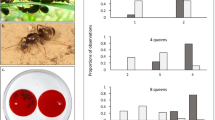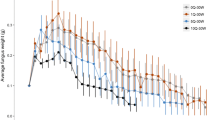Abstract
One of the main tasks a freshly mated ant queen has to face is to find a safe and suitable nest site to start a new colony. Colony foundation by associated queens, also known as pleometrosis, has been described for several ant species and, under specific selective pressures, represents an alternative to independent colony foundation. Despite most newly mated queens of the common Mediterranean acrobat ant Crematogaster scutellaris generally adopting independent colony foundation inside tree trunks, both field and laboratory studies have demonstrated that the formation of pleometrotic groups may occur, particularly inside lignified aphid galls on poplar or oak trees. These associations typically end with the survival of only one queen after the foundation phase, and the benefits they may provide remain unclear. In this study, we investigated how queen density and different nest availability may promote the formation of pleometrotic associations in C. scutellaris. We found that occupied nests are not actively sought after by queens, as hypothesised in previous studies, but might be accepted when they are the only safe refugia available. Moreover, the tendency to form groups increases as queen density increases, and nest availability is a limiting factor. Finally, we found no evidence that the size of the queen affects whether to join an already occupied nest.


Similar content being viewed by others
References
Adams ES, Tschinkel WR (1995) Effects of foundress number on brood raids and queen survival in the fire ant Solenopsis invicta. Behav Ecol Sociobiol 37:233–242
Aron S, Steinhauer N, Fournier D (2009) Influence of queen phenotype, investment and maternity apportionment on the outcome of fights in cooperative foundations of the ant Lasius niger. Anim Behav 77:1067–1074
Balas MT (2005) Conditions favoring queen execution in young social insect colonies. Insect Soc 52:77–83
Balas MT, Adams ES (1996) The dissolution of cooperative groups: mechanisms of queen mortality in incipient fire ant colonies. Behav Ecol Sociobiol 38:391–399
Baroni Urbani C (1971) Catalogo delle specie di Formicidae d’Italia (studi sulla mirmecofauna d’Italia X). Mem Soc Ent Ital 50:5–287
Baroni Urbani C, Souliè J (1962) Monogynie chez la fourmi Cremastogaster scutellaris (Hymenoptera:Formicidae). Bull Soc Hist Nat Toulouse 97:29–34
Bartz SH, HÓ§lldobler B (1982) Colony founding in Myrmecocystus mimicus wheeler and the evolution of foundress associations. Behav Ecol Sociobiol 10:137–147
Bernasconi G, Keller L (1999) Effect of queen phenotype and social environment on early queen mortality in incipient colonies of the fire ant, Solenopsis invicta. Anim Behav 57:371–377
Bernasconi G, Strassmann JE (1999) Cooperation among unrelated individuals: the ant foundress case. Trends Ecol Evol 14:477–482
Breed M (2017) Forced queen associations. Insect Soc 2:177–178
Cahan S, Helms KR, Rissing SW (1998) An abrupt transition in colony founding behaviour in the ant Messor pergandei. Anim Behav 55:1583–1594
Cahan SH, Fewell JH (2004) Division of labor and the evolution of task sharing in queen associations of the harvester ant Pogonomyrmex californicus. Behav Ecol Soc 56:9–17
Casevitz-Weulersse J (1972) Habitat et comportement de Crematogaster scutellaris OLIVER (Hymenoptera: Formicidae). Bull Soc Entomol Fr 77:12–19
Casevitz-Weulersse J (1991) Reproduction et développement des sociétés de Crematogaster scutellaris OLIVER (Hymenoptera:Formicidae). Ann Soc Entomol Fr 27:103–111
Cole B (2009) The ecological setting of social evolution: the demography of ant populations. In: Gadau J, Fewell JH (eds) Organization of insect societies: from genome to sociocomplexity. Harvard University Press, Cambridge, pp 74–105
Fournier D, Battaille G, Timmermans I, Aron S (2008) Genetic diversity, worker size polymorphism and division of labour in the polyandrous ant Cataglyphis cursor. Anim Behav 75:151–158
Frizzi F, Panichi S, Rispoli A, Masoni A, Santini G (2014) Spatial variation of the aggressive response towards conspecifics in the ant Crematogaster scutellaris (Hymenoptera Formicidae). Redia 97:165–169
Frizzi F, Ciofi C, Dapporto L, Natali C, Chelazzi G, Turillazzi S, Santini G (2015) The rules of aggression: how genetic, chemical and spatial factors affect intercolony fights in a dominant species, the mediterranean acrobat ant Crematogaster scutellaris. PloS One 10(10)
Han DA, Tschinkel WR (1997) Settlement and distribution of colony-founding queens of the arboreal ant, Crematogaster ashmeadi, in a longleaf pine forest. Insect Soc 44:323–336
Heinze J, Trunzer B, Hölldobler B, Delabie JHC (2001) Reproductive skew and queen relatedness in an ant with primary polygyny. Insect Soc 48:149–153
Helmkampf M, Mikheyev AS, Kang Y, Fewell J, Gadau J (2016) Gene expression and variation in social aggression by queens of the harvester ant Pogonomyrmex californicus. Mol Ecol 25:3716–3730
Helms KR, Helms Cahan S (2012) Large-scale regional variation in cooperation and conflict among queens of the desert ant Messor pergandei. Anim Behav 84:499–507
Herbers JM (1986) Nest site limitation and facultative polygyny in the ant Leptothorax longispinosus. Behav Ecol Sociobiol 19:115–122
Hood WG, Tschinkel WR (1990) Desiccation resistance in arboreal and terrestrial ants. Physiol Entomol 15:23–35
Hölldobler B, Wilson EO (1977) The number of queens: an important trait in ant evolution. Naturwissenschaften 64:8–15
Hölldobler B, Wilson EO (1990) The ants. Springer, Berlin
Hölldobler B, Wilson EO (2009) The superorganism: the beauty, elegance, and strangeness of insect societies. Norton, New York
Kellner K, Trindl A, Heinze J, d’Ettorre P (2007) Polygyny and polyandry in small ant societies. Mol Ecol 16:2363–2369
Keller L, Passera L (1989) Size and fat content of gynes in relation to the mode of colony founding in ants (Hymenoptera; Formicidae). Oecol 80:236–240
Kemp DJ, Wiklund C (2004) Residency effects in animal contests. Proc R Soc Lond B 271:1707–1712
Krebs RA, Rissing SW (1991) Preference for larger foundress associations in the desert ant Messor pergandei. Anim Behav 41:361–363
Jeanson R, Fewell JH (2008) Influence of the social context on division of labor in ant foundress associations. Behav Ecol 19:567–574
Johnson RA (2004) Colony founding by pleometrosis in the semiclaustral seed-harvester ant Pogonomyrmex californicus (Hymenoptera: Formicidae). Anim Behav 68:1189–1200
Masoni A, Frizzi F, Mattioli M, Turillazzi S, Ciofi C, Santini G (2017) Pleometrotic colony foundation in the ant Crematogaster scutellaris (Hymenoptera: Formicidae): better be alone than in bad company. Myrmecol News 25:51–59
Masoni A (2017) Ecology and behaviour of the dominant ant Crematogaster scutellaris (Olivier 1792). PhD dissertation, Università degli studi di Firenze
Motro M, Motro U, Cohen D (2016) Decision making by young queens of the harvester ant Messor semirufus while searching for a suitable nesting site. Insect Soc 63:615–622
Motro M, Motro U, Cohen D (2017) Forced associations by young queens of the harvester ant Messor semirufus during colony founding. Insect Soc 64:179–187
Nonacs P (1990) Size and kinship affect success of co-founding Lasius pallitarsis queens. Psyche 97:217–228
Nonacs P (1992) Queen condition and alate density affect pleometrosis in the ant Lasius pallitarsis. Insect Soc 39:3–13
Overson RP (2011) Causes and consequences of queen-number variation in the California harvester ant Pogonomyrmex californicus. Dissertation, Arizona State University
Overson R, Gadau J, Clark RM, Pratt SC, Fewell JH (2014) Behavioral transitions with the evolution of cooperative nest founding by harvester ant queens. Behav Ecol Soc 68:21–30
Pfenning DW (1995) Absence of joint nesting advantage in desert seed harvester ants: evidence from a field experiment. Anim Behav 49:567–575
Rissing SW, Johnson RA, Pollock GB (1986) Natal nest distribution and pleometrosis in the desert leaf-cutter ant Acromyrmex versicolor (Pergande) (Hymenoptera: Formicidae). Psyche 93:177–186
Rissing SW, Pollock GB (1987) Queen aggression, pleometrotic advantage and brood raiding in the ant Veromessor pergandei (Hymenoptera Formicidae). Anim Behav 35:975–981
Rueppell O, Heinze J (1999) Alternative reproductive tactics in females: the case of size polymorphism in winged ant queens. Insect Soc 46:6–17
Santini G, Tucci L, Ottonetti L, Frizzi F (2007) Competition trade-offs in the organisation of a Mediterranean ant assemblage. Ecol Entom 32:319–326
Sasaki K, Jibiki E, Satoh T, Obara Y (2005) Queen phenotype and behaviour during cooperative colony founding in Polyrhachis moesta. Insect Soc 52:19–25
Schneider CA, Rasband WS, Eliceiri KW (2012) NIH Image to ImageJ: 25 years of image analysis. Nat Methods 9:671–675
Shaffer Z, Sasaki T, Haney B, Janssen M, Pratt SC, Fewell JH (2016) The foundress’s dilemma: group selection for cooperation among queens of the harvester ant, Pogonomyrmex californicus. Sci Rep 6:29828
Sommer K, Hölldobler B (1995) Colony founding by queen association and determinants of reduction in queen number in the ant Lasius niger. Anim Behav 50:287–294
Trunzer B, Heinze J, Hölldobler B (1998) Cooperative colony founding and experimental primary polygyny in the ponerine ant Pachycondyla villosa. Insect Soc 45:267–276
Tschinkel WR, Howard DF (1983) Colony founding by pleometrosis in the fire ant, Solenopsis invicta. Behav Ecol Soc 12:103–113
Tschinkel WR (1993) Sociometry and sociogenesis of colonies of the fire ant Solenopsis invicta during one annual cycle. Ecol Monogr 63:425–457
Tschinkel WR (2006) The fire ants. Harvard University Press, Cambridge
Vargo EL (1992) Mutual pheromonal inhibition among queens in polygyne colonies of the fire ant Solenopsis invicta. Behav Ecol Soc 31:205–210
Author information
Authors and Affiliations
Corresponding author
Rights and permissions
About this article
Cite this article
Masoni, A., Frizzi, F., Turillazzi, S. et al. Making the right choice: how Crematogaster scutellaris queens choose to co-found in relation to nest availability. Insect. Soc. 66, 257–263 (2019). https://doi.org/10.1007/s00040-018-00683-8
Received:
Revised:
Accepted:
Published:
Issue Date:
DOI: https://doi.org/10.1007/s00040-018-00683-8




